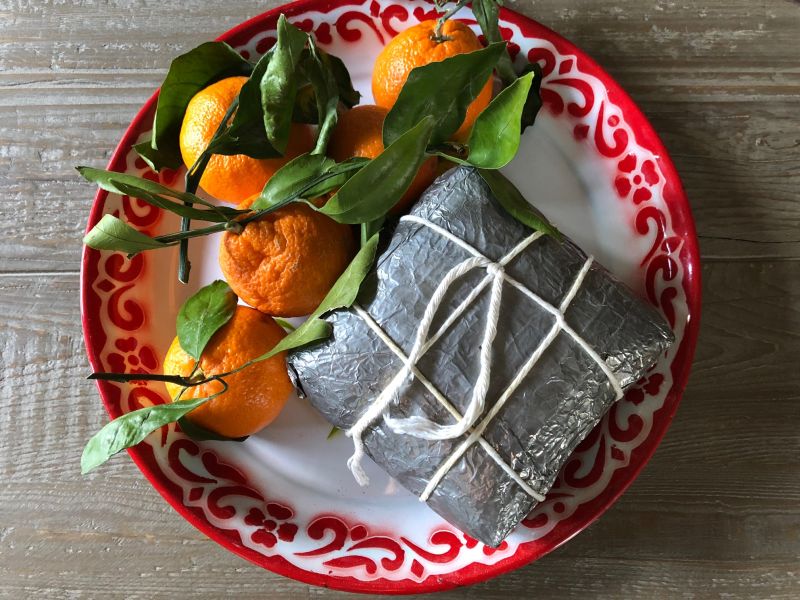
It’s a triple whammy this week -- Mardi Gras/Lent, Valentine’s Day, and Lunar New Year. There is a lot to celebrate, whatever your faith or culture. For Vietnamese people, we’re eyeing Tet on Friday, February 16. It’ll kick off the Year of the Dog (woof!), a great opportunity to look forward with optimism and enthusiasm, to hit the reset button, and to eat a lot of food with family and friends.
At the center of Vietnamese Tet menus is banh chung, a special sticky rice cake filled with butter yellow mung beans and fatty pork. It’s hearty yet delicately fragrant and stained green because it’s wrapped in tropical green leaves (la dong in Vietnam and banana leaf and bamboo leaves abroad).
Banh chung is chubby and squarish, like an adobe brick-size. Southern Vietnamese people take the same ingredients and wrap them up as cylinders that resemble small neck pillows. My apologies for sounding crude with the descriptors but how else can I explain the size of these things?
Banh Chung Symbolism
My family is northern Vietnamese in heritage so we make banh chung. There’s a mythical story behind how banh chung was created by a clever prince to symbolize the humble and delicious resourcefulness of the Vietnamese people. Indeed, made of just a handful of pantry ingredients, the cakes taste marvelously good.
My first book editor, a man who’d eaten many fanciful meals, was over the moon when he sampled banh chung. Ditto for my food stylist and friend, Karen Shinto, whom I gift banh chung to. Robyn Eckhardt, a friend and former Saigon resident, requested banh chung when we flew from HCMC to Malaysia to visit her.
But banh chung means more than national pride and deliciousness. It’s also about family and group cooking projects. Just like dumplings and tamales, you don’t just make one. You get people together to make a bunch and then share in the banh chung bounty! It’s comfort food.
My mom recollects making them in her childhood, with banh chung cooking in cauldrons heated by wood and straw. In America, she has mailed banh chung via USPS Priority Mail to my sisters, brother and nieces.
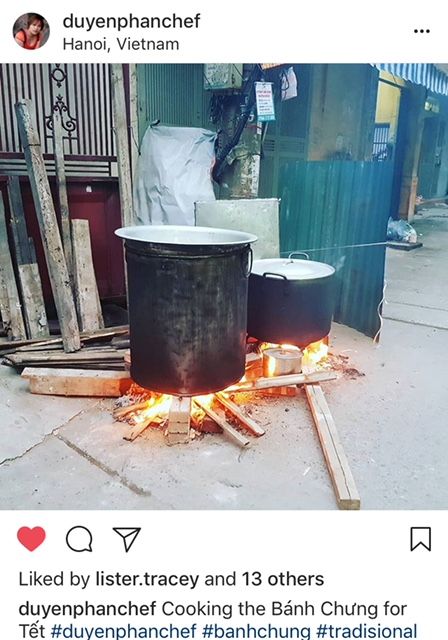
The other day when I posted a frozen banh chung, @curiouskitkat tweeted that her mom had just made 24 banh tet! She also tweeted a photo of her mom, Hue Thonkily.
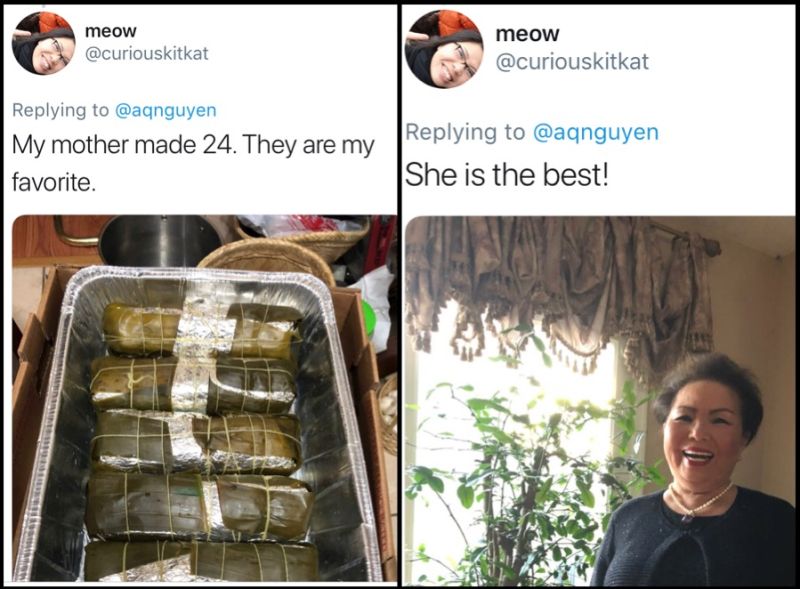
To be honest, I’ve never had a store-bought banh chung. My mom always made them and taught me how. So I make the Tet sticky rice cake myself. A detailed recipe is in my first-born, Into the Vietnamese Kitchen, plus I have step-by-step photos of how to wrap banh chung. If you’re doubtful about making them, check out Barbara’s excellent banh chung adventure.
But many people buy them. There’s no shame in that. Vietnamese delis, bakeries and markets have tables of banh chung and banh tet right now. Buy one or two and keep them till this weekend in the fridge to prevent spoilage (before the days of refrigeration, you tied them up and kept them in a well, my mom said).
How to Refresh Banh Chung
Made with sticky rice, fully cooked banh chung hardens in the fridge and freezer (you can freeze them for 12 months!). Regardless of how you keep the sticky rice cake, you should refresh them to allow them to be the best they can be. I keep mine frozen and wrapped in foil and so it’s just a matter of bringing it to room temperature and then boiling it. Store-bought banh chung (or banh tet) lack foil, so for a precautionary measure to guard against rice leaks, wrap it in foil and tie it up with kitchen string.
Put the banh chung in a pot and add water to cover by a good knuckle’s worth (1 ¼ inches). Bring to a boil and then let it bubble away for 30 minutes. Turn the sticky rice cake around the 10-minute mark for even cooking.
Mine are roughly 5 inch square and 3 inches thick. You’ll know yours is refreshed because the cake expands and puffs a bit. If you stick a skewer in the middle, it should go in easily and come out warm. Here’s a temperature test, too.
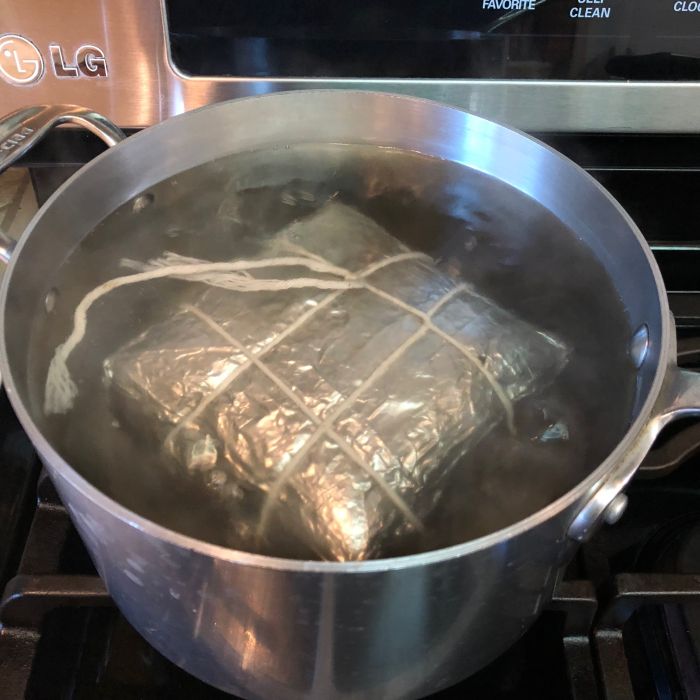
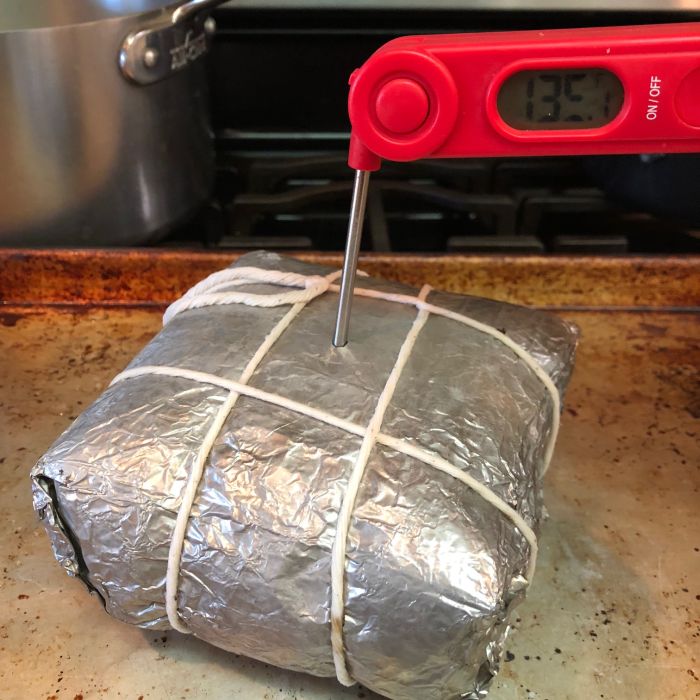
After boiling, let banh chung rest to cool for about 30 minutes. Weight it down with a large can of tomatoes to compress it. Otherwise, it may not remain intact when you later cut it.
You can eat banh chung warm or at room temperature. Once a banh chung has been cut, you can reheat wedges in the microwave oven, or panfry (see below).
How to Cut Banh Chung
It’s sticky and messy so how do you gracefully attack it? Because of banh chung’s square shape, and because I want an even distribution of all the filling, and because I want to show off the inside, I cut triangular wedges using fine kitchen string. Some people use floss. It’s up to you!
Cut four pieces of string, each about 24 to 30 inches long. Set them aside.
Unwrap the banh chung, leaving some banana leaf on the bottom to allow you to maneuver the cake later. Have a presentation plate nearby to invert the cake on to.
Place the pieces of string in an asterisk pattern, pulling down on the string ends to secure it in the cake. I typically make the string descend about halfway into the cake. For easy clean up later on, cover the top with some leaves (recycle the wrapping leaves) or parchment.
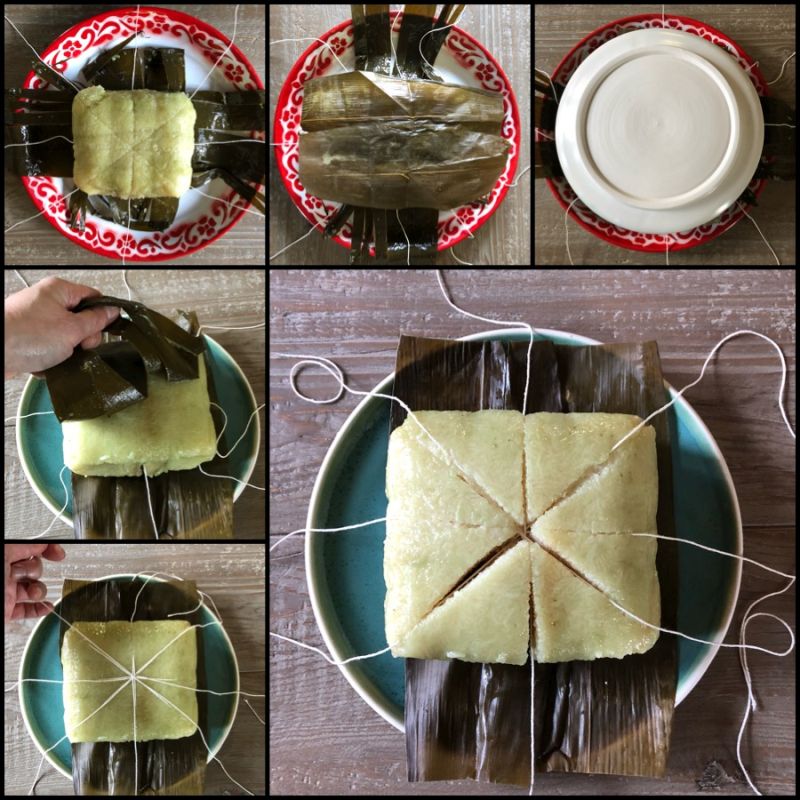
Put the presentation plate on top, then invert the cake. Peel off the banana leaf facing you. One by one, pull on the string ends to bring them up toward the center. Pause close to the top. When you’ve done this to all four of the strings, they’ll be gathered in the middle. Grab all the strings and pull them up to cut the cake into 8 triangular wedges. Viola! You’re a banh chung master!
How to Eat Banh Chung
Enjoy the soft, fragrant wedges with a little sugar, which nicely contrasts with the savoriness of the filling and brings out the sweetness of the rice. Typically, banh chung is enjoyed with Viet charcuterie -- the cold cuts used in banh mi, and pickled vegetables (try the daikon and carrot pickle for a simple one). It can be part of a elaborate spread with pork or beef simmered in caramel sauce, too.
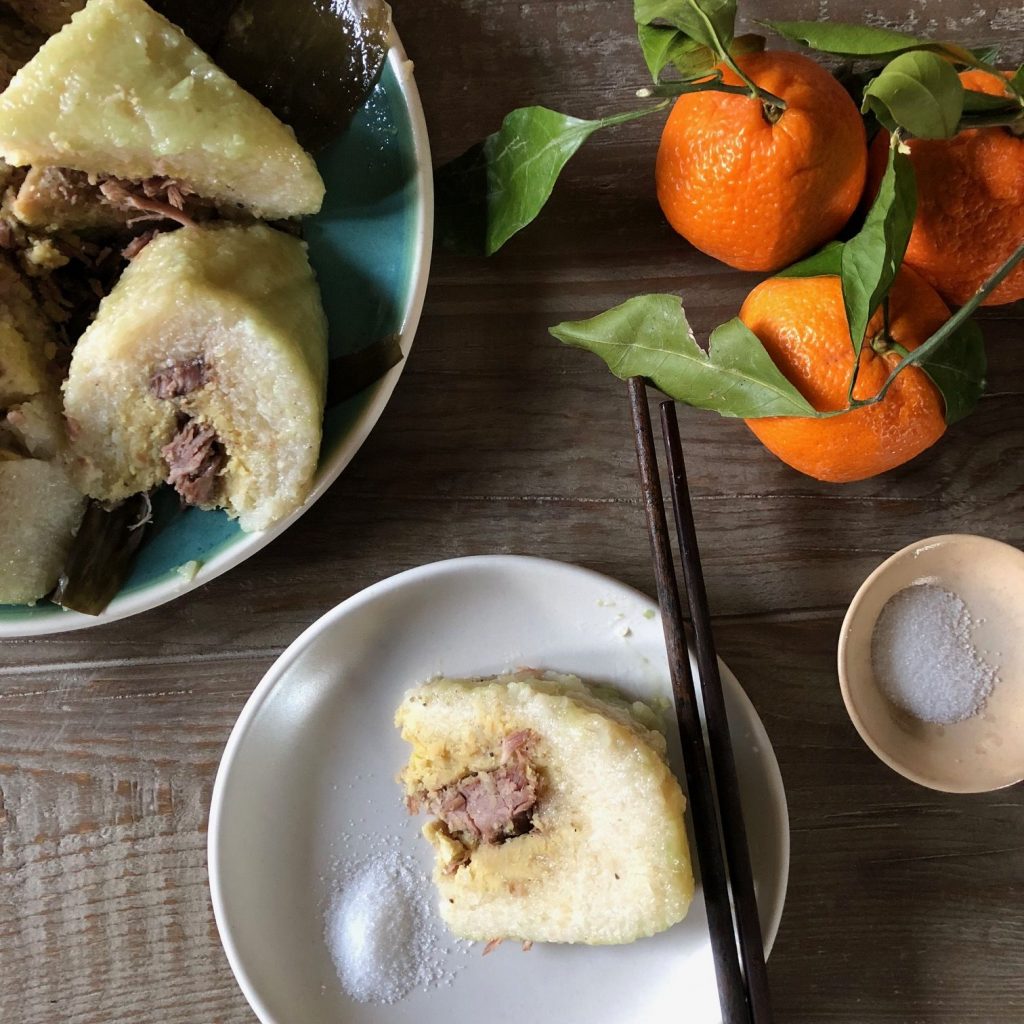
After eating banh chung wedges fresh like this, I pan fry leftovers into a pancake. (You may just serve them as a pancake and no one would grumble.)
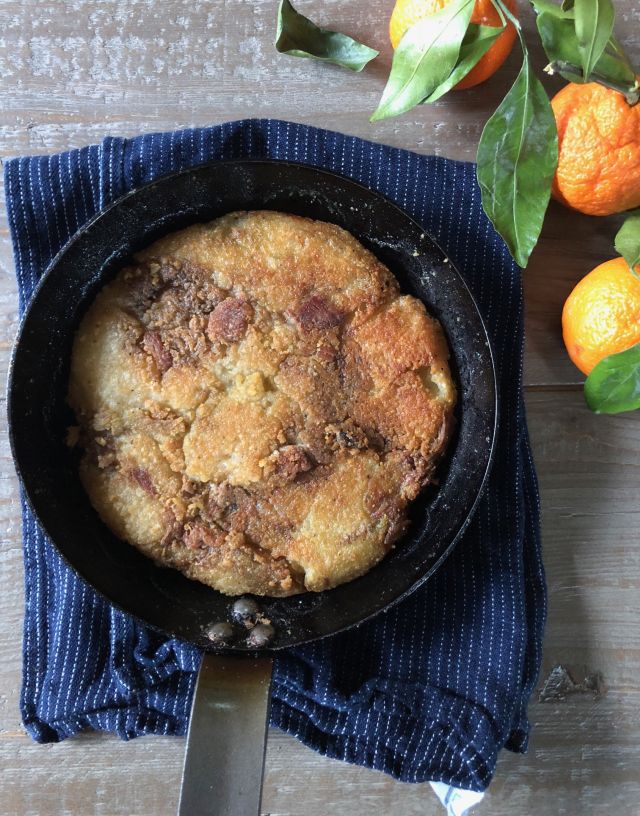
During frying, the rice, beans, and pork coalesce into a crisp, chewy exterior that’s delightful. For instructions, head to the pan-fried banh chung recipe!
If you have banh tet, cut them into 1-inch-thick slices and enjoy them as is, or pan-fried! I’ve seen them deep-fried as well. Just saying.
Tet is a fun time to eat, cook, and hang out. It’s the ultimate Vietnamese holiday. Embrace it with a full appetite!

















Emma Cohen-Joppa says
Thank you for this post! I'm an expat in Ho Chi Minh City, and my landlord just gifted me a banh chung as we were finishing our supper a couple of hours ago - which was the beef pho from your great recipe! I look forward to the leftover pho for breakfast. Soon I'll head to the banks of the saigon river to look for fireworks, and tomorrow I'll have my first ever banh chung!
Chuc mung nam moi!
Andrea Nguyen says
Glad to be of help! Thanks for writing!
Elizabeth Andoh says
WONDERFUL! Thank you, Andrea for the details of both technique and culture.
All best from Tokyo (the Japanese shifted to the Gregorian calendar with the Meiji Restoration (1868) so the new year begins here on January 1. So I will wish you a belated-from-Japan Happy New Year!
Andrea Nguyen says
Thank you, Elizabeth!!! Happy New Year to you and your family. So great to hear from you, as always!
This site says
Thank you for this post! Happy New Year to you and your family. I wish you only the best!